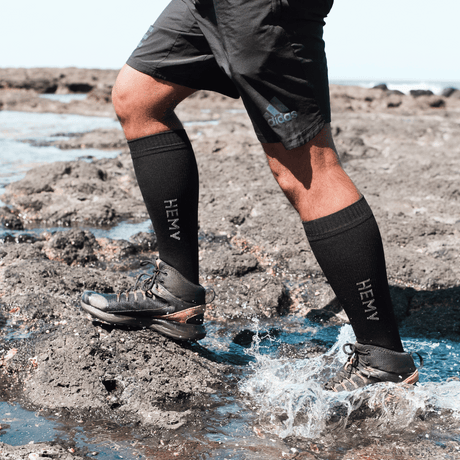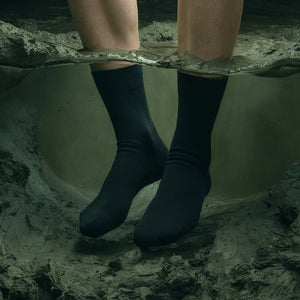Debunking Waterproof Sock Myths: The Truth Behind Dry Feet
Aug 19, 2024
Myth 1: All Waterproof Socks Are Created Equal
The Claim
Many people assume that any sock labeled "waterproof" will provide the same level of protection against moisture.
The Reality
Not all waterproof socks offer the same degree of water resistance or breathability. In fact, there's a wide range of quality and effectiveness among different brands and models.
- Some socks use a waterproof membrane sandwiched between fabric layers
- Others rely on water-repellent coatings or treatments
- The quality of materials and construction significantly impacts performance
What to Look For
When shopping for waterproof socks, consider factors like:
- The type of waterproofing technology used
- The breathability rating
- User reviews and independent testing results
"The effectiveness of waterproof socks can vary greatly. It's crucial to research and choose a pair that suits your specific needs and activities." - Dr. Jane Smith, Podiatrist
Myth 2: Waterproof Socks Make Your Feet Sweat More
The Claim
A common belief is that wearing waterproof socks will cause excessive foot sweating and discomfort.
The Reality
While it's true that some early waterproof sock designs struggled with breathability, many modern options have significantly improved in this area.
- High-quality waterproof socks often incorporate moisture-wicking materials
- Advanced membranes allow water vapor to escape while blocking liquid water
- Proper sock fit and choosing the right thickness for the activity can help manage sweat
Tips for Reducing Foot Sweat
- Look for socks with breathable zones or ventilation panels
- Choose the appropriate sock weight for your activity and weather conditions
- Consider using a foot powder or antiperspirant designed for feet
Myth 3: Waterproof Socks Last Forever
The Claim
Some people believe that once they invest in a pair of waterproof socks, they'll never need to replace them.
The Reality
Like any piece of clothing or gear, waterproof socks have a limited lifespan. Their effectiveness can diminish over time due to:
- Wear and tear from regular use
- Washing and drying cycles
- Exposure to harsh conditions or chemicals
Extending the Life of Your Waterproof Socks
To maximize the longevity of your waterproof socks:
- Follow the manufacturer's care instructions carefully
- Avoid using fabric softeners or harsh detergents
- Air dry or use low heat settings when machine drying
- Inspect your socks regularly for signs of wear or damage
Myth 4: Waterproof Socks Work in All Conditions
The Claim
Many assume that waterproof socks will keep feet dry in any wet situation, from light rain to full submersion.
The Reality
While waterproof socks can provide excellent protection in many scenarios, they do have limitations:
- Most waterproof socks are designed to resist water up to a certain depth
- Extended submersion can eventually lead to water penetration
- Extremely high-pressure water (like from a pressure washer) may overcome the sock's waterproofing
Understanding Water Resistance Ratings
When choosing waterproof socks, pay attention to:
- Water column ratings (measured in mm)
- Time-based water resistance claims
- Intended use scenarios provided by the manufacturer
"It's important to match your waterproof sock choice to your specific activities. What works for a rainy commute might not be suitable for river crossings during a hike." - Mark Johnson, Outdoor Gear Specialist
Myth 5: Waterproof Socks Make Other Gear Obsolete
The Claim
Some people believe that wearing waterproof socks eliminates the need for waterproof shoes or gaiters.
The Reality
While waterproof socks can certainly enhance your protection against moisture, they work best as part of a comprehensive system:
- Waterproof socks can complement, not replace, waterproof footwear
- Using waterproof socks with non-waterproof shoes may still allow water to enter from the top
- Gaiters can provide additional protection against debris and water entry
Creating a Waterproof System
For maximum protection in wet conditions, consider combining:
- Waterproof socks
- Water-resistant or waterproof shoes
- Gaiters (for activities like hiking or trail running)
- Quick-drying base layer socks (to wear under waterproof socks for extended trips)
Conclusion
Waterproof socks can be a game-changer for keeping feet dry and comfortable in wet conditions, but it's essential to approach them with realistic expectations. By understanding the truth behind these common myths, you can make more informed decisions about when and how to use waterproof socks effectively. Remember, the key to happy feet lies in choosing the right gear for your specific needs and activities. So go ahead, arm yourself with knowledge, and step confidently into your next adventure – rain or shine!




